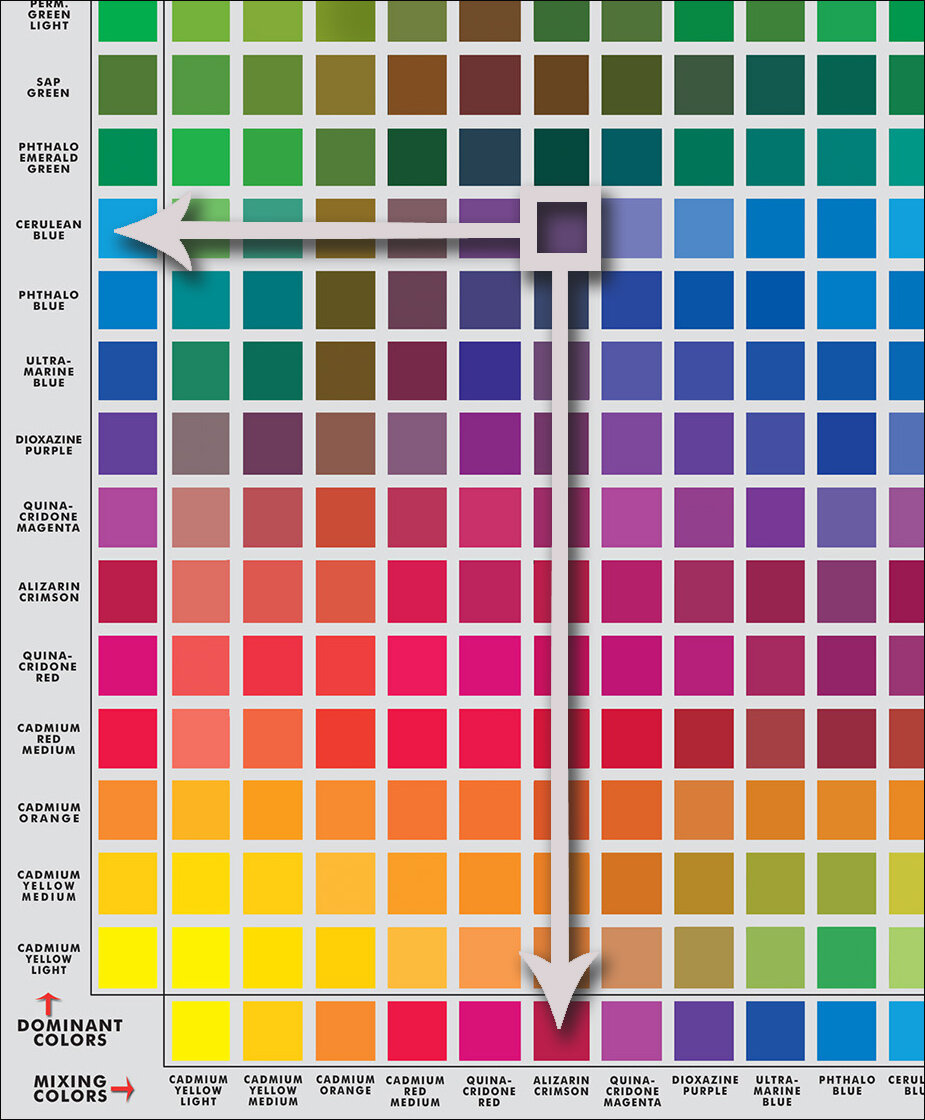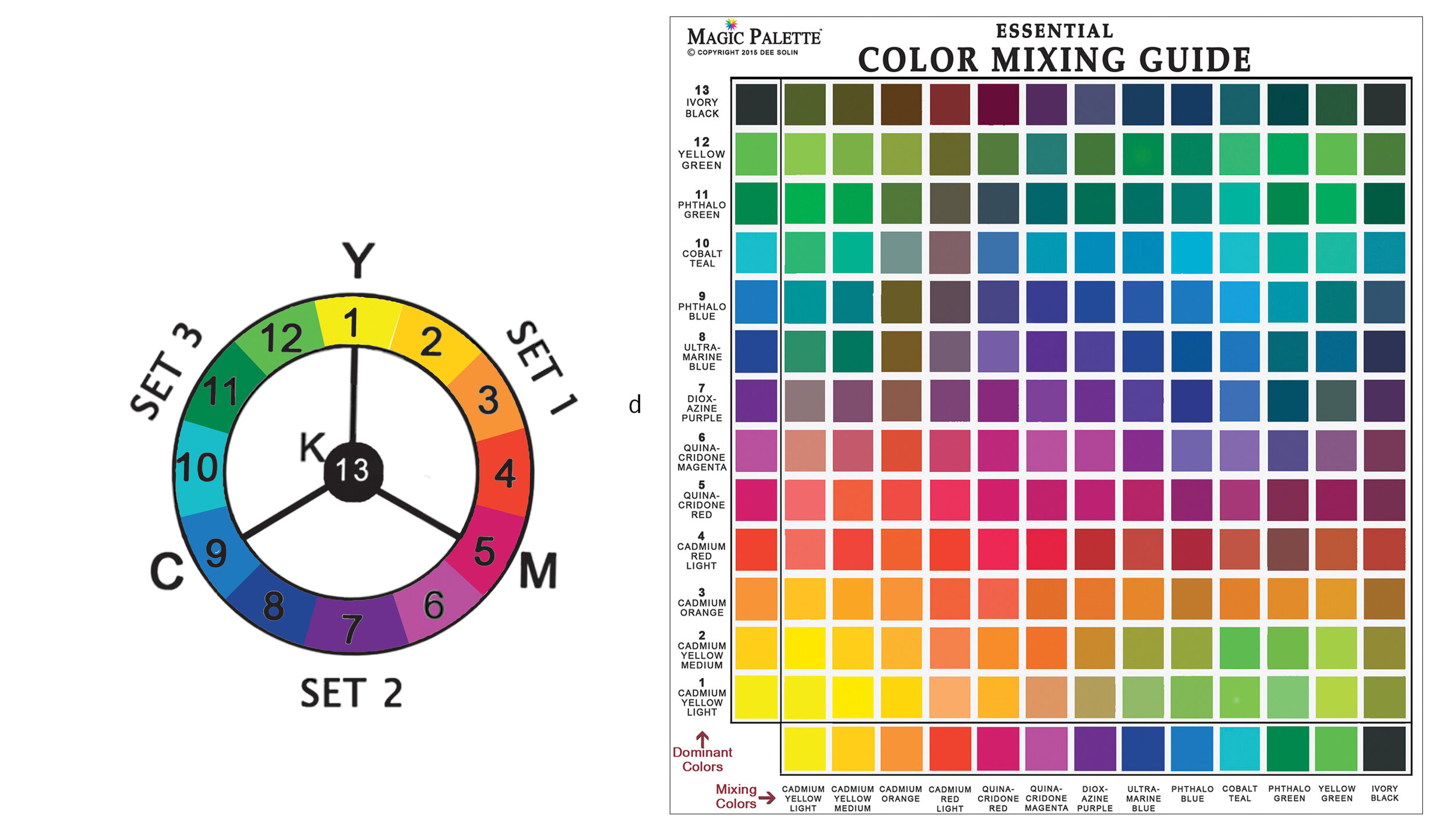The How To Page
Introduction
Our Color Mixing Guides feature historic fine art pigments commonly found in a variety of artists paints, tubes, mediums and generic heterogeneous blends. There are 28 pure pigment colors in the original Magic Palette System, representing a full range of spectral hues and earth pigments. Our guides are designed to encourage experimentation and develop visual fluency.
The Studio Guide (24” x 24”) features 28 key colors and 841 luminous color mixtures.
The Personal Guide (11 1/2” x 11 1/2”) features 18 key colors with 324 luminous color mixtures
The Essential Guide (6 1/2” x 7”) features 12 essential color wheel hues, with the most basic primary, secondary and tertiary pigment colors.
Our color guides offer a full spectrum of artists colors and color combinations for you to create using your paint medium of choice; oil, acrylic, watercolor and more.
How the Grid Works
Choose the color you wish to create and find it’s dominant color. Start with this. Next find it’s mixing color directly below. Add this to the dominant color in small increments with a palette knife. Use the guide to create favorite new colors and combinations.If a hue is too dark mix in a little white.
Complete instructions are included with every Magic Palette Guide.
Our Magic Palette Essential Color Mixing Guide and the Color Mixing Wheel
Our essential Color Mixing Guides feature 12 important Color Wheel Hues (plus black). These are effective colors for learning basic color theory and practical color mixing using real paints. The guide offers a new learning experience, encourages experimentation and discovery.
For vivid colors mix two colors from the same set.
For muted colors mix two colors from different sets.
For grey colors mix two colors opposite each other on the wheel.
To mix CMYK colors use only #5 cyan , #9 magenta, #1 yellow and #13 black
The Color Matching Guide Fan with 36 pigments Color Wheel.
The new Color Matching Guide features a bonus color wheel showing the position of each of the 36 pigment colors to help you build harmonious color relationships and cohesive color schemes.
The Matching Guide Color Wheel positions 36 artist colors around the circle so you can easily see color relationships. Complements are two colors on the opposite side of the color wheel. When you place complements together the result is a high contrast, high impact color combination. Analogous color schemes are typically comprised of three colors that fall next to each other on the color wheel resulting in soft contrast, harmonious effects.
Paint Colors and Pigments
Studio Color Mixing Guide
Cadmium Yellow Light (Py35)
Cadmium Yellow Medium (Py35)
Naples Yellow (Py43 Py37 Pw4)
Yellow Ochre (Py43)
Indian Yellow (Py 83)
Cadmium Orange (Po20)
Cadmium Red Light (Pr108)
Cadmium Red Medium (Pr108)
Quinacridone Red (Pv19)
Cadmium Red Deep (Pr108)
Alizarin Crimson (Pr83)
Quinacridone Magenta (Pr122)
Dioxazine Purple (Pv23)
Ultramarine Blue (Pb29)
Cobalt Blue (Pb28)
Phthalo Blue (Pb15:1) green shade
Cerulean Blue (Pb35)
Cobalt Teal (Pb28)
Phthalo Green (Pg36)
Sap Green (Pb15,Py83)
Permanent Green Light (Py74, Pg7)
Yellow Green (Py3, Py97, Pg36, Pw6)
Raw Sienna (Pbr7)
Burnt Sienna (Pbr7)
Indian Red (Pr101)
Burnt Umber (Pbr7)
Raw Umber (Pbr7)
Paynes Grey (Pb29, Pbk9, Py42)
Ivory Black (Pbk9)
Titanium White (Pw6 or Pw6, Pw4)
Color Matching Guide
Cadmium Yellow Light (Py35)
Cadmium Yellow Medium (Py35)
Naples Yellow (Py43 Py37 Pw4)
Yellow Ochre (Py43)
Indian Yellow (Py 83)
Cadmium Orange (Po20)
Cadmium Red Light (Pr108)
Cadmium Red Medium (Pr108)
Quinacridone Red (Pv19)
Cadmium Red Deep (Pr108)
Alizarin Crimson (Pr83)
Quinacridone Magenta (Pr122)
Dioxazine Purple (Pv23)
Ultramarine Blue (Pb29)
Cobalt Blue (Pb28)
Phthalo Blue (Pb15:1) green shade
Cerulean Blue (Pb35)
Cobalt Teal (Pb28)
Phthalo Green (Pg36)
Sap Green (Pb15,Py83)
Permanent Green Light (Py74, Pg7)
Yellow Green (Py3, Py97, Pg36, Pw6)
Raw Sienna (Pbr7)
Burnt Sienna (Pbr7)
Indian Red (Pr101)
Burnt Umber (Pbr7)
Raw Umber (Pbr7)
Paynes Grey (Pb29, Pbk9, Py42)
Ivory Black (Pbk9)
Titanium White (Pw6 or Pw6, Pw4)
Personal Color Mixing Guide
Cadmium Yellow Light (Py35)
Cadmium Yellow Medium (Py35)
Cadmium Orange (Po20)
Cadmium Red Medium (Pr108)
Quinacridone Red (Pv19)
Alizarin Crimson (Pr83)
Quinacridone Magenta (Pr122)
Dioxazine Purple (Pv23)
Ultramarine Blue (Pb29)
Phthalo Blue Green Shade (Pb15:1)
Cerulean Blue (Pb35)
Phthalo Green (Pg36)
Sap Green (Pb15,Py83)
Permanent Green Light (Py74, Pg7)
Burnt Sienna (Pbr7)
Raw Umber (Pbr7)
Paynes Grey (Pb29, Pbk9, Py42)
Ivory Black (Pbk9)
Titanium White (Pw6 or Pw6, Pw4)
Essential Color Mixing Guide
Cadmium Yellow Light (Py35)
Cadmium Yellow Medium (Py35)
Cadmium Orange (Po20)
Cadmium Red Light (Pr108)
Quinacridone Red (Pv19)
Quinacridone Magenta (Pr122)
Dioxazine Purple (Pv23)
Ultramarine Blue (Pb29)
Phthalo Blue Green Shade (Pb15:1)
Cobalt Teal (Pb28)
Phthalo Green (Pg36)
Yellow Green (Py3, Py97, Pg36, Pw6)
Ivory Black (Pbk9)
Titanium White (Pw6 or Pw6, Pw4)






